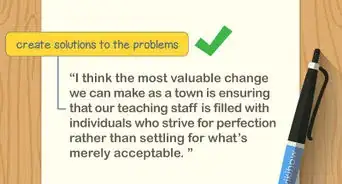This article was co-authored by Katie Styzek. Katie Styzek is a Professional School Counselor for Chicago Public Schools. Katie earned a BS in Elementary Education with a Concentration in Mathematics from the University of Illinois at Urbana-Champaign. She served as a middle school mathematics, science, and social studies teacher for three years prior to becoming a counselor. She holds a Master of Education (M.Ed.) in School Counseling from DePaul University and an MA in Educational Leadership from Northeastern Illinois University. Katie holds an Illinois School Counselor Endorsement License (Type 73 Service Personnel), an Illinois Principal License (formerly Type 75), and an Illinois Elementary Education Teaching License (Type 03, K – 9). She is also Nationally Board Certified in School Counseling from the National Board for Professional Teaching Standards.
wikiHow marks an article as reader-approved once it receives enough positive feedback. In this case, several readers have written to tell us that this article was helpful to them, earning it our reader-approved status.
This article has been viewed 159,653 times.
If you’re a natural leader and you want to make some changes in your school, you might be thinking about running for Student Council President. Going up against other students and trying to gain the popularity of the school can be intimidating, but by making the right moves, you can give opposing candidates a run for their money. Make sure to participate early on, establish and maintain relationships with your peers, and market yourself well to successfully run for Student Council President.
Steps
Participating Early
-
1Run for a student council position early. The Student Government or Student Council at your school is the elected governing body that plans and executes programs that the school can benefit from in one way or another. Run for a position as early on as you can. If you’re elected, you’ll be seen participating in and helping to organize fundraisers, fun events, and more. This will also allow you to gain the experience you need to be an effective president later on.[1]
-
2Run for smaller positions first. Most of the time, every grade level has a president, vice president, secretary, and treasurer, so don’t automatically start off running for the highest position available. Even if you get elected to be the treasurer or the secretary, it can help you to establish yourself in a leadership role and start climbing the ladder towards the presidency.[2]Advertisement
-
3Familiarize yourself with the rules. Every school has their own unique process for electing students. Make sure to learn about application deadlines, obligatory paperwork, and any other requirements for running. You can get this information from the adults at the school who lead and oversee the student council. This will keep you from overlooking something and getting disqualified or appearing unprepared when you run for presidency.[3]
-
4Join clubs and participate in school functions.[4] Most schools have a wide variety of club options from athletic teams (soccer, football, volleyball, etc.), to artistic clubs (chorus, dance, photography), and many others in between. Read through the list of different clubs that your school offers and attend two or three meetings of different clubs that involve something of interest to you. Additionally, make sure to attend all social events that your school holds, such as prom. Consistently participating in these after school activities will allow you to get to know students who you may not have normally crossed paths with.
- Joining debate club is a good option if you want to improve your public speaking skills for your campaign speech.[5]
Establishing and Maintaining Relationships
-
1Acquire a responsible reputation. If you want a shot at being elected president, you need to always present yourself as a responsible, professional individual. This will help students who know you well or just a little feel like they can trust you. Try to participate in class discussions and make good grades.[6] Being known as the student who is always sleeping in class or is always on their cell phone won’t inspire others to trust or respect you.[7]
-
2Find out what other students want and need. Promising flashy, fun, and temporary services like a water slide or free cake might help you gain a few students’ vote, but the only way to gain true loyalty is by listening to the wants and needs of the students and making it your focus to help them. This might mean talking to the principal about adding a vegetarian lunch option or asking teachers to volunteer to stay at school an hour late once a week so that struggling students can have a study hall.[8]
- Make sure to survey students from different social circles and backgrounds to get this information.
-
3Try to remember what students tell you. Do your best to make a mental note about the different things you learn about people. Even remembering their name and saying “Hi, Ashley!” or “How’s it going, Ron?” in the hallway will make them feel truly noticed and cared for.[9]
- For example, if an acquaintance tells you in passing that they’re going to Florida for spring break and you see them on the first day back from school, you could walk up to them and ask how they enjoyed their time in Florida.
-
4Make connections for students. Once you start getting to know many of the students at your school, you’ll start to notice that one student’s problem could be helped by another particular student. When you notice this, make sure to speak up. This shows that you have an impressive network but also that you are considerate enough to use it to help others.[10]
- For example, if you overhear a couple of cheerleaders trying to figure out where they can hold their annual car wash fundraiser, you might suggest the parking lot of a local business that you know another student’s family owns.
-
5Invite everyone to everything. If your friend asks you to do something outside of school or you get an idea for an activity on your own, spread the word and let everyone know they’re welcome to join. This shows that you’re inclusive and don’t discriminate.[11]
- If a couple of your close friends want to go bowling on Saturday night, spread the word to everyone you talk to that week. At the end of the conversation you might say: “Hey, I almost forgot. A bunch of us are getting together to go bowling on Saturday night. It would be awesome if you could join us!”
Marketing Yourself
-
1Create a vision. Based on the wants and needs of the students, develop a solid, realistic purpose for your campaign that can benefit everyone the most. Is there something that really needs to be changed? Have you discovered an opportunity to make a difference? Identify your vision and begin to communicate it as much as you can.[12]
- If you’ve overheard several students talking about their struggles with being bullied at school, you might decide that your vision should have an accepting, inclusive, anti-bullying focus.
- If your school only does one volunteer activity each year that a lot of students enjoy doing together, you might create a vision on paying it forward and plan to provide more volunteer activities and events.
-
2Come up with a catchy slogan. Come up with one good, catchy slogan to put on all of your marketing materials. Something like “Jack for Council President” is boring and overdone, so get creative and come up with something that communicates your vision, rhymes, or makes a comedic reference.[13]
- If you want a funny rhyming slogan, try one like “Don’t be wack, vote for Jack!”
-
3Put up posters and give handouts. Putting attractive, eye-catching posters all around the school with your slogan is a necessity. Post them everywhere that you think people walk by frequently. Also, create buttons, pencils, or fliers with your slogan on them to hand out at school. These will get your name out there and possibly even communicate your message and intention.[14]
- For example, if your vision is about bringing together students of different backgrounds and social circles, you might create an artistic poster that has only the word “unite” in all caps and features drawings or headshots of the faces of a few different students who have varying styles and ethnicities.
- Consider how many students go to your school when deciding how many posters you hang. If only about 100 students go to your school, you can hang 10 posters or less. If your school has 1,000 students or more, you may want to put up closer to 50 posters.
-
4Spread the word with social media. Use technology to your advantage and create groups, post promotional videos, etc. to have a presence on social media websites such as Facebook, Twitter, and Instagram. This gets the word out off campus and also gives people another opportunity to connect with you, show support for you, and learn about you.[15]
-
5Write and give a solid speech. Your campaign speech may be the last (or only!) bit of information that students hear from you until it’s time for them to vote. Because of this, it’s important that you write, practice, and give a strong speech spanning about 2-3 minutes. In your speech, you should:
- Introduce yourself
- Explain why they should vote for you by talking briefly about your qualifications and positive personal characteristics
- State your platform/express what you’d like to change
- Explain how you are going to accomplish goals and make changes
- Finish with your slogan[16]
Expert Q&A
Did you know you can get expert answers for this article?
Unlock expert answers by supporting wikiHow
-
QuestionWhat qualities do I need as a student council president?
 Katie StyzekKatie Styzek is a Professional School Counselor for Chicago Public Schools. Katie earned a BS in Elementary Education with a Concentration in Mathematics from the University of Illinois at Urbana-Champaign. She served as a middle school mathematics, science, and social studies teacher for three years prior to becoming a counselor. She holds a Master of Education (M.Ed.) in School Counseling from DePaul University and an MA in Educational Leadership from Northeastern Illinois University. Katie holds an Illinois School Counselor Endorsement License (Type 73 Service Personnel), an Illinois Principal License (formerly Type 75), and an Illinois Elementary Education Teaching License (Type 03, K – 9). She is also Nationally Board Certified in School Counseling from the National Board for Professional Teaching Standards.
Katie StyzekKatie Styzek is a Professional School Counselor for Chicago Public Schools. Katie earned a BS in Elementary Education with a Concentration in Mathematics from the University of Illinois at Urbana-Champaign. She served as a middle school mathematics, science, and social studies teacher for three years prior to becoming a counselor. She holds a Master of Education (M.Ed.) in School Counseling from DePaul University and an MA in Educational Leadership from Northeastern Illinois University. Katie holds an Illinois School Counselor Endorsement License (Type 73 Service Personnel), an Illinois Principal License (formerly Type 75), and an Illinois Elementary Education Teaching License (Type 03, K – 9). She is also Nationally Board Certified in School Counseling from the National Board for Professional Teaching Standards.
Professional School Counselor
-
QuestionHow do you get people to go on your side?
 Community AnswerThere are different strategies that you can use to get people on your side. Firstly, they'll be more inclined to vote for you if they've had good interactions with you. Make sure that you're kind, friendly, and respectful to everyone at your school. Secondly, make sure that your vision and goals match up with what the majority of students at your school care about and want.
Community AnswerThere are different strategies that you can use to get people on your side. Firstly, they'll be more inclined to vote for you if they've had good interactions with you. Make sure that you're kind, friendly, and respectful to everyone at your school. Secondly, make sure that your vision and goals match up with what the majority of students at your school care about and want. -
QuestionHow do you make campaign buttons with your face on it?
 Community AnswerCheck out this wikiHow article on how to make button pins at home.
Community AnswerCheck out this wikiHow article on how to make button pins at home.
Warnings
- Don't smear the opposition. This makes you look like a poor sport and will definitely cost you when voting time rolls around.⧼thumbs_response⧽
- Don’t reference national politics. This might drive away or even offend some of your supporters.⧼thumbs_response⧽
- Don't use bribes. Not only is this against the rules in some schools, but bribing students will also cost you votes.⧼thumbs_response⧽
- Don't go overboard with the humor; nothing wins votes like a good joke and nothing loses them like a bad or overused one.⧼thumbs_response⧽
- A lot of the time, student elections are nothing more than a popularity contest. Even if you worked the hardest and were the most qualified, you still might lose.⧼thumbs_response⧽
References
- ↑ http://blog.prepscholar.com/how-to-join-student-council
- ↑ http://blog.prepscholar.com/how-to-get-elected-class-president
- ↑ https://www.thoughtco.com/how-to-run-for-student-council-1857201
- ↑ Katie Styzek. Professional School Counselor. Expert Interview. 28 October 2020.
- ↑ Katie Styzek. Professional School Counselor. Expert Interview. 28 October 2020.
- ↑ Katie Styzek. Professional School Counselor. Expert Interview. 28 October 2020.
- ↑ http://blog.prepscholar.com/how-to-get-elected-class-president
- ↑ http://www.presence.io/blog/5-tips-for-running-a-successful-student-government-campaign/
- ↑ https://www.themuse.com/advice/42-ways-to-make-sure-people-like-youand-respect-you
- ↑ https://www.themuse.com/advice/42-ways-to-make-sure-people-like-youand-respect-you
- ↑ https://www.themuse.com/advice/42-ways-to-make-sure-people-like-youand-respect-you
- ↑ http://www.presence.io/blog/5-tips-for-running-a-successful-student-government-campaign/
- ↑ http://blog.prepscholar.com/how-to-get-elected-class-president
- ↑ http://blog.prepscholar.com/how-to-get-elected-class-president
- ↑ http://www.presence.io/blog/5-tips-for-running-a-successful-student-government-campaign/
- ↑ http://blog.prepscholar.com/how-to-get-elected-class-president
- ↑ Katie Styzek. Professional School Counselor. Expert Interview. 28 October 2020.












































































